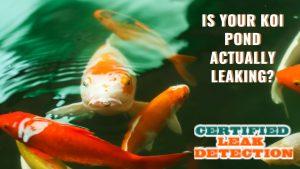
A koi pond on your property provides a Zen-like level of serenity. However, keeping your fish healthy and providing the right environment for them to thrive is a responsibility that can, ironically, be stressful. One cause for concern is a leak in your pond.
Your pond will naturally lose some water due to certain environmental factors and design-related issues – which include splash-out, flaws in the waterfall design, length of the stream, and type of water feature. Environmental factors include wind, relative humidity, water plants, wicking, lack of shade, pond surface area and cloud cover.
In Central Florida, evaporation during summer’s intense heat is a typical cause of water loss, with 1″ to 2″ per week common. But if your pond starts losing water beyond that amount, you need to look for leaks. For detection methods that require shutting off the pump, of course, use your backup pond aeration kit.
Start by checking the waterfall
If your koi pond has a waterfall and/or stream, start your inspection there. Check the edges of these features. When the dirt around the waterfall or stream settles, it might form low spots that can cause the water to run through the edge of the liner. Carefully look for mulch, gravel, or muddy spaces around the border of your pond. If you see the leak, you can easily repair it. All you need to do is lift the liner and put some soil under it to raise the edge.
Pond leaks also can develop when the water is too high in the waterfall filter box. This situation occurs when the water inside the box rises too high and flows out the sides or back rather than out the front. Some common issues that would cause this include a filter box that is not level, leaning away from the stream, or a slate rock piece that is too thick sitting on the lip of the waterfall filter causing the water to rise up too high in the waterfall filter.
To remedy this situation, Paradise Ponds and Waterfalls recommends removing the waterfall slate piece entirely from the lip of the filter. Then run your pond for a 24-hour leak check. If the leak has stopped, use waterfall foam to install a new thinner slate piece or leave the piece off entirely. Another area to check at the waterfall filter is the pond liner and filter faceplate connection. Ensure that the screws and silicone holding the liner to the filter faceplate are in good condition and still in place.
Could your pump be the problem?
If you’re able to rule out the waterfall/stream as the source of the problem, turn your attention to the pump. The pros at PondScape recommend the following step-by-step detection method:
- Fill the pond water up to the appropriate level.
- Unplug the pump.
- Let the pond sit for 24 hours.
- After 24 hours, check the water level. If the water level of the pond has not dropped, then the leak is not in the pond itself.
- Check all fittings, plumbing, and pump connections for leaks. The problem may be somewhere in the plumbing.
- If the water has dropped, you do have a leak in your pond.
- To find out where the leak is occurring, allow the water level to continue to drop. The level where the water stops dropping is the level where the leak is located.
You will have to first remove the rocks around the border of your pond until you see the place where the water has settled. Check the liner for a hole or puncture. Once you see the leak’s location, patch it up. If there is no drop in the water level, the leak might be in your plumbing or equipment outside the pond. Kink-free tubing becomes brittle over time, leading to small cracks or pinhole leaks.
Paradise Ponds and Waterfalls also recommends checking for leaks around PVC connection fittings, barbed tubing connections, clamps, O-rings and gaskets. In addition, check around the base of the filter for water, and inspect the plastic filter housing for cracks. The area around the external pond filter may be damp or wet, depending on the severity of the leak. Cracks in pond filter connections can be caused by seasonal weather changes, long-term sun exposure, and equipment age.
Looking for leaks in the liner
Leaks that occur only when the pump is turned on can indicate a leak in the liner. PondScape recommends the following steps to detect this issue:
- Use a yardstick to take a measurement of the water level and recheck it again every 24 hours, at the same time of day if possible, for three days.
- If your pond is losing water quickly, turn off the main pond pump and continue to measure. If the water level continues to drop, the problem is in the main pond liner.
- If this is the case, keep measuring until a stopping point is reached, then look around the complete inside perimeter of the pond where the water level has leveled off for a hole in the liner or low edge. You may need to refill the pond again with an inch or two of water to confirm the area at which the pond stops leaking.
Other possible causes for leaks or holes in the liner include tree roots spreading or burrowing animals.
Fortunately, most repairs are of the DIY variety. The crew at Next Day Koi provides comprehensive, step-by-step instructions for common types of koi pond leaks.
However, if your pond is still losing water and you’re unable to find the reason, give us a call! Certified Leak Detection is experienced in leak detection and repair for fountains, swimming pools, spas, and hot tubs, as well as slabs and foundations. Serving areas throughout Central Florida – including Orlando, Longwood, Lake Mary, Sanford, Kissimmee, Clermont and Winter Springs – our team is ready to help. Contact us for quick, reliable service.

